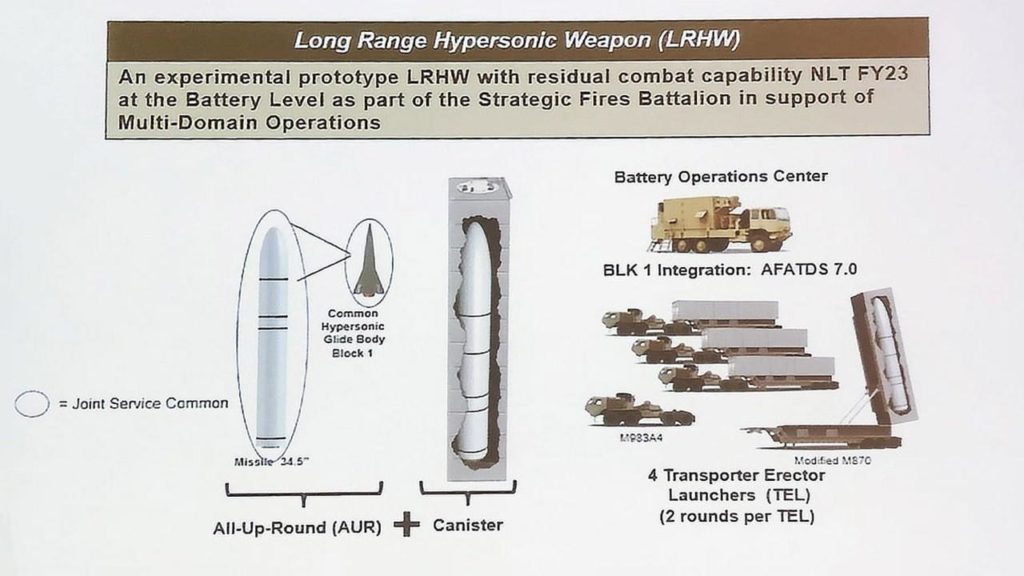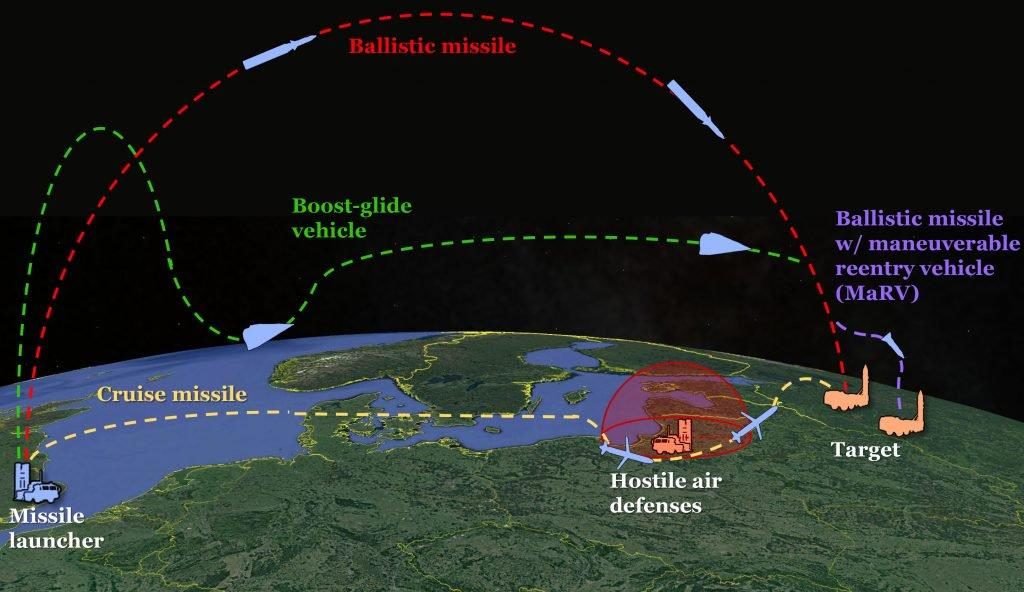Originally appeared at ZeroHedge
The race for hypersonic missiles heated up last week when the US Army awarded two key contracts to catch up to Russia and China. After a decade of experimental prototypes, the Army is expected to get its hands on hypersonic missiles that will be fielded in the next four years, reported Breaking Defense.
Dynetics won the first contract to produce 20 Common Hypersonic Glide Bodies (C-HGB) for both the Army and the Navy.
Lockheed Martin won the second, with a $347 million contract to upgrade eight of the C-HGBs with guidance systems, rocket boosters, protective canisters, and a missile battery that can house four Long Range Hypersonic Weapon (LRHW) launchers.
Due to the urgency of developing hypersonic technologies, both contracts used Other Transaction Authority (OTA) to bypass the usual procurement process to field the weapons faster.
The Army’s rapid acquisition chief, Lt. Gen. Neil Thurgood, recently said the hypersonic missile battery would become operational after a series of field tests. Deployment of the new hypersonic missile could be as soon as 2023, Thurgood said.
Although the Dynetics contract is for the Army, the Navy and Air Force will receive weapon components from the defense firm for their hypersonic missiles.
The Marine Corps doesn’t have a hypersonic missile acquisition program but could acquire the Army’s land-based version in 2023.
Dynetics is building the C-HGB, a hypersonic glider that is deployed from the missile after launch and can travel Mach 5 or higher. The glider can outmaneuver the world’s advanced missile defense shields.
The Army and Navy will use the same missile with a C-HGB warhead. Other services will integrate different booster rockets and a slightly different C-HGB design to met various demands of launching from planes, vessels, and even submarines, the report said.
The Air Force version of the C-HGB, has to be mounted on a strategic bomber, and or a fifth-generation fighter jet, needs a slightly different glide body but uses 70% of the same components from the Amry’s Dynetics contract.
Last month, the Air Force awarded a $480 million hypersonic missile contract to Lockheed Martin Missiles & Fire Control to develop a hypersonic weapon prototype.
And Lockheed received an even larger contract in April, totaling more than $900 million to build a Hypersonic Conventional Strike Weapon (HCSW) for the service.
“Lockheed Martin is driving rapid technical development for these national priority programs,” said Eric Scherff, vice president for Hypersonic Strike Programs for Lockheed Martin Space.
“There are natural synergies with our industry teammates. We believe our relationships offer the Army unmatched expertise and put us in the best position to deliver this critical capability to the nation.”
While all three services are racing to field hypersonic weapons, the Army hasn’t had a long-range weapon since the Pershing II missile of the Cold War. Russia and China are years ahead in hypersonic development versus the US.
The Pentagon has recently sounded the alarm on the proliferation of hypersonic technological advances that are being made around the world [mainly in China and Russia].
“Although hypersonic glide vehicles and missiles flying non-ballistic trajectories were first proposed as far back as World War II, technological advances are only now making these systems practicable,” Vice Admiral James Syring, director of the US Missile Defense Agency, said in June, during testimony before the US House Armed Services Committee.
Vice-Chairman of the Joint Chiefs Air Force Gen. Paul Selva told reporters in January of last year that “We have lost our technical advantage in hypersonics; we haven’t lost the hypersonics fight. China has made it a national program, so China’s willing to spend tens to up to hundreds of billions to solve the problem of hypersonic flight, hypersonic target designation, and then ultimately engagement.”
In March 2018, the US Strategic Commander told the Senate Armed Services Committee that the US is vulnerable to future attack via hypersonic missiles and is quickly falling behind the technological curve for hypersonic technologies.
“We [US] don’t have any defense that could deny the employment of such a weapon [hypersonic missiles] against us,” warned Air Force Gen. John Hyten, commander of Us Strategic Command.
Hyten further said, “both Russia and China are aggressively pursuing hypersonic capabilities. We have watched them test those capabilities.”
“I think we have stability with Russia on the nuclear side,” he added. “We have an advantage with China on the nuclear side. But they are gaining ground quickly, especially when you look at space and cyber.”
In March 2018, Russia test-fired a high-precision Kinzhal (Dagger) hypersonic missile from a MiG-31 supersonic interceptor jet in the South Military District in Russia’s southwest.
“The launch went according to plan, the hypersonic missile hit its target,” the Ministry of Defence of the Russian Federation declared.
The defense ministry released exclusive video showing the hypersonic missile air launch from the underbelly of the MiG-31.
Экипаж истребителя МиГ-31 Воздушно-космических сил #ВКС выполнил практический учебно-боевой пуск гиперзвуковой ракеты высокоточного авиационного ракетного комплекса #Кинжал в заданном районе. Пуск прошел штатно, гиперзвуковая ракета поразила заданную цель на полигоне pic.twitter.com/xLguUwGrQW
— Минобороны России (@mod_russia) March 10, 2018
In June 2019, Russia successful test-fired a new hypersonic interceptor missile with capabilities that are so advanced, no other country has a similar weapon.
На полигоне Сары-Шаган (Республики Казахстан) боевым расчетом войск противовоздушной и противоракетной обороны ВКС успешно проведен очередной испытательный пуск новой ракеты российской системы противоракетной обороны (ПРО)#Минобороны #ВКС #ПРО #Казахстан #СарыШаган pic.twitter.com/mhtveLcJ3N
— Минобороны России (@mod_russia) June 4, 2019
In late 2017, China conducted several tests of a hypersonic glide vehicle that could be used to defeat US missile defense systems.
https://twitter.com/soraywang/status/927286374193012736
In August 2018, China claimed to have successfully tested a new hypersonic missile that would be capable of penetrating any missile defense system in the world. The Starry Sky-2, which is an experimental design known as “waverider,” rides the shock waves generated during flight. The missile could one day carry conventional and or nuclear warheads undetected through US missile defense shields.
#China has successfully tested its new aircraft, the Starry Sky-2, which can even be used to carry nuclear missiles at a speed never seen before. Recently China & #Russia showed the world their new toys. For whom they display it? What intention is behind that? #defense #Military pic.twitter.com/XqA2AsleZn
— Cristina Font 柯伊娜 (@cfontharo) August 7, 2018
It should be increasingly clear why the Pentagon is racing to field hypersonic missiles in various services in the next four years, that’s because of a rising China and Russia appear to be outgunning the US in hypersonic technology.








